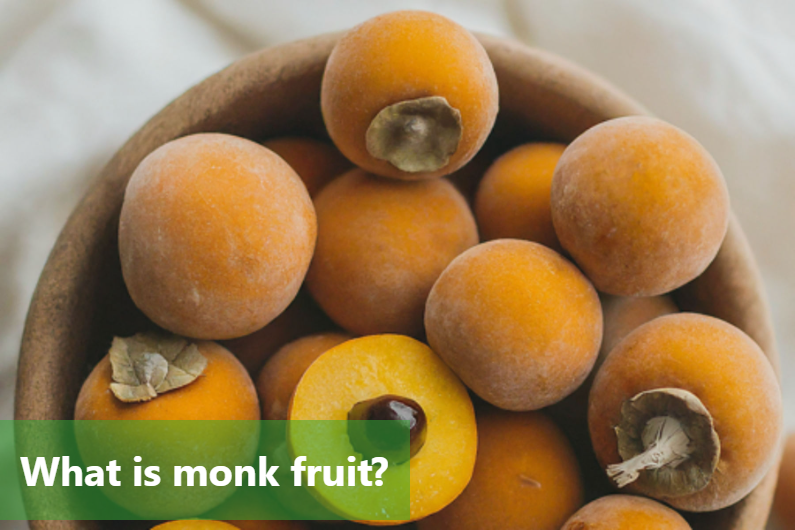Monk fruit, also called Buddha fruit, is a small, round fruit from southern China, used in traditional Chinese medicine for its sweetness and healing properties. It's gaining popularity as a natural sweetener due to its unique health benefits and zero-calorie nature, making it a sought-after choice for health-conscious consumers. This fruit has a fascinating history tracing back to the 13th century when it was named after Buddhist monks known as "luohan," who first cultivated it. The labor-intensive cultivation process involves hand-picking the fruit and extracting its sweeteners. The resulting monk fruit sweetener has gained immense popularity in recent years.
Monk Fruit Composition and Taste
Monk fruit, also referred to as "luo han guo," is a diminutive, green gourd-shaped fruit indigenous to Southern China. It houses natural sweetening agents named mogrosides, notably mogroside V, bestowing upon it a sweetness that far surpasses that of sugar. Remarkably, this sweetness is attained sans the calories or abrupt surge in blood sugar levels often linked with the consumption of regular sugar.
When it comes to taste, monk fruit offers a delightful sweetness with a slightly fruity undertone, lending it a unique flavor profile. The absence of any aftertaste sets it apart from other artificial sweeteners, making it a desirable choice for those looking to reduce their sugar intake without compromising on taste. The pleasant and natural flavor of monk fruit makes it a versatile ingredient in various culinary applications and is widely appreciated by individuals seeking a healthier alternative to sugar and artificial sweeteners.
In essence, the natural compounds present in monk fruit contribute to its exceptional sweetness, while its pleasant taste makes it a sought-after option for individuals looking to satiate their sweet tooth without the drawbacks of traditional sugar.
Uses and Benefits of Monk Fruit
Uses
Sweeten sauces, dressings, and marinades in cooking to enhance the flavor profile of a wide variety of dishes.
Replace sugar in baking to create healthier and low-calorie desserts without compromising on taste.
Sweeten hot and cold beverages to enjoy a delightful sweetness without the guilt of high sugar consumption.
Benefits
With a low glycemic index, it is ideal for managing blood sugar levels and supporting a balanced diet.
Its significantly sweeter nature than sugar means only a small amount is needed, making it more cost-effective.
Contributes to lower overall caloric intake, making it a great choice for those attempting to maintain a healthy lifestyle.
The Downsides of Monk Fruit
Bitter Aftertaste
Some people find that monk fruit sweeteners can have a bitter aftertaste, especially when used in large quantities or in certain food and beverage applications. This may not be appealing to everyone's palate.
Cost
Monk fruit sweeteners can be more expensive than other natural sweeteners, such as stevia or erythritol. This cost factor can make it less accessible to some consumers.
Limited Availability
While monk fruit sweeteners are becoming more widely available, they may still be harder to find in some regions compared to other sweeteners. This limited availability could be a downside for those who prefer to purchase their sweeteners from local retailers.
Digestive Issues
In some cases, consuming monk fruit sweetener in large amounts may cause digestive discomfort, such as bloating or diarrhea, especially when combined with other high-fiber or sugar alcohols.
It's important for individuals to weigh the pros and cons of monk fruit sweeteners and consider their personal health and taste preferences when deciding whether to incorporate this sweetener into their diet.
Monk Fruit Allergies
Some individuals may experience allergic reactions to monk fruit, such as:
Skin rashes
Itchy or swollen skin
Hives
Nausea or vomiting
Difficulty breathing
If you suspect an allergy to monk fruit, it's important to consult with a healthcare professional for proper diagnosis and management.
Ways to Use Monk Fruit
Monk fruit is a versatile natural sweetener that can be used in various ways to enhance the flavor of your favorite dishes and beverages. Here are five creative ways to incorporate monk fruit into your daily routine:
Beverage Sweetener: Add monk fruit sweetener to your morning coffee, tea, or smoothie for a healthy and natural sweetness without the calories of sugar.
Baking: Use monk fruit sweetener in your favorite baking recipes to create delicious desserts and treats without the guilt of consuming excessive sugar.
Sauces and Marinades: Incorporate monk fruit sweetener into homemade sauces and marinades to balance out the flavors and reduce the overall sugar content of your dishes.
Salad Dressings: Create homemade salad dressings with monk fruit sweetener for a healthier alternative to store-bought dressings that are often high in added sugars.
Yogurts and Parfaits: Sweeten up your yogurt or parfait with a sprinkle of monk fruit sweetener for a naturally sweet and low-calorie option.
Experiment with monk fruit sweetener in various recipes to find out how it can elevate the taste of your favorite foods and drinks while keeping your sugar intake in check.
Monk Fruit Recipes
Are you looking for some amazing monk fruit recipes? Look no further! Here are some delicious and healthy recipes that you can try using monk fruit as a natural sweetener. Monk fruit is a fantastic alternative to sugar and is perfect for those who are looking to cut down on their sugar consumption. Check out these great monk fruit recipes below:
Monk Fruit Sweetened Lemonade
This refreshing and tangy lemonade is sweetened with monk fruit instead of traditional sugar, making it a healthier option for a hot summer day.
Monk Fruit Chocolate Chip Cookies
Indulge your sweet tooth with these scrumptious chocolate chip cookies sweetened with monk fruit. They are just as delicious as traditional cookies but without the guilt!
Monk Fruit Vanilla Smoothie
Start your day with a nutritious and flavorful vanilla smoothie that gets its sweetness from monk fruit. It's a great way to add a little sweetness to your morning routine without the added sugar.
Monk Fruit Sweetened Oatmeal
Upgrade your breakfast with a bowl of warm and comforting oatmeal sweetened with monk fruit. It's a hearty and healthy way to start your day.
Try these monk fruit recipes to satisfy your cravings for something sweet while keeping your sugar intake in check. Enjoy the natural sweetness of monk fruit in these delectable dishes
Frequently Asked Questions About Monk Fruit
Q: What is monk fruit? A: Monk fruit, also known as Luo Han Guo, is a small round fruit native to southern China. It has been used in traditional Chinese medicine for centuries and is known for its intense sweetness.
Q: Is monk fruit sweetener safe? A: Yes, monk fruit sweetener is considered safe for most people. It contains no calories and does not affect blood sugar levels, making it a popular natural alternative to sugar for those with diabetes or those looking to reduce their sugar intake.
Q: How is monk fruit sweetener made? A: Monk fruit sweetener is made by extracting the natural sweetness from the fruit using a process that involves crushing the fruit and collecting the juice, which is then dried into a concentrated powdered form.
Q: Is monk fruit good for weight loss? A: Monk fruit sweetener can be a helpful option for those looking to manage their weight due to its zero-calorie content. It provides a sweet taste without the added calories of sugar, making it a suitable choice for weight-conscious individuals.
Q: Are there any health benefits of monk fruit? A: Monk fruit contains antioxidants called mogrosides, which are believed to have anti-inflammatory properties and may help protect against certain chronic diseases. Additionally, it does not contribute to tooth decay, making it a tooth-friendly sweetening option.
This Blog post is an initiative by DiabeSmart, to provide accurate and Nutritionist / Doctor approved information related to Diabetes. DiabeSmart is India's first Food brand designed specifically for Diabetics, that has been clinically tested on Diabetics and Pre-Diabetics to deliver 55% - 70% lower Sugar spikes. DiabeSmart is part of Lo! Foods - India's leading brand for Everyday Functional Health foods.











